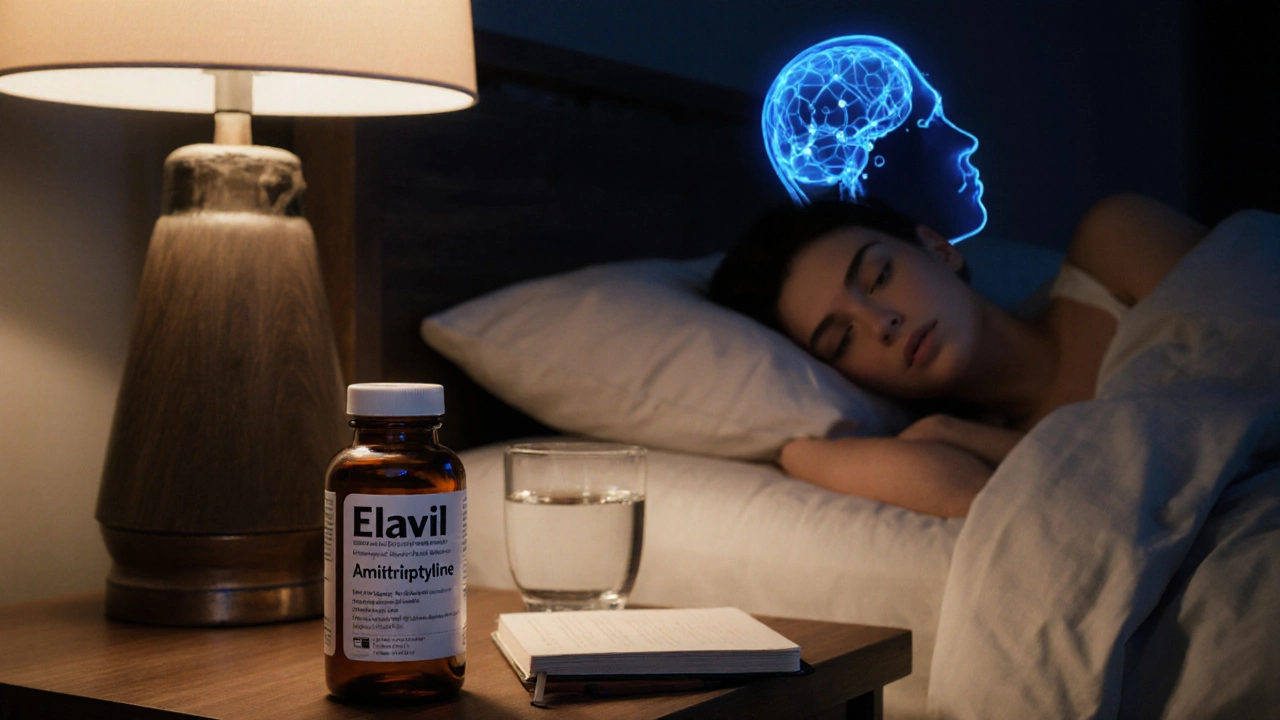Compare Elavil (Amitriptyline) with Alternatives - Benefits, Side Effects & Best Options
 Oct, 8 2025
Oct, 8 2025
Elavil vs. Alternatives Comparison Tool
Recommended Medication Based on Your Criteria:
Key Takeaways
- Elavil (Amitriptyline) is a tricyclic antidepressant useful for depression, chronic pain, and migraine prevention.
- Common alternatives include newer antidepressants (SSRIs, SNRIs) and neuropathic‑pain agents.
- Side‑effect profiles differ: Amitriptyline has more anticholinergic effects, while SSRIs tend to cause GI upset and sexual dysfunction.
- Choosing the right drug depends on the primary condition, tolerated side effects, and drug‑interaction risk.
- Non‑drug options such as CBT or lifestyle changes can complement or replace medication for some patients.
Amitriptyline has been a mainstay in mental‑health and pain medicine for decades, but newer agents often promise fewer side effects. Below we unpack how Elavil measures up against the most common alternatives.
What Is Elavil (Amitriptyline)?
Amitriptyline is a tricyclic antidepressant (TCA) originally developed in the 1960s to treat major depressive disorder. In practice, physicians also use it for neuropathic pain, tension‑type headaches, and as a sleep aid at low doses. Its chemical structure blocks the reuptake of serotonin and norepinephrine, boosting mood‑regulating neurotransmitters.
The brand name Elavil refers specifically to the marketed formulation of Amitriptyline. Typical adult dosing for depression starts at 25mg nightly, titrating up to 150‑300mg per day, while pain management often stays between 10‑50mg at bedtime.
How Do Tricyclic Antidepressants Work?
Tricyclic antidepressant is a drug class that inhibits the reabsorption of serotonin and norepinephrine, increasing their levels in the brain. They also antagonize histamine H1, muscarinic acetylcholine, and α1‑adrenergic receptors, which explains many of their side effects such as dry mouth, weight gain, and drowsiness.
Because TCAs affect several receptor systems, they can be useful for conditions beyond mood disorders, but the same breadth raises safety concerns-especially in overdose scenarios.

Common Alternatives to Amitriptyline
When clinicians consider alternatives, they look at the primary indication, side‑effect tolerance, and drug‑interaction profile. Below are the most frequently prescribed substitutes.
- Sertraline is a selective serotonin reuptake inhibitor (SSRI) commonly used for depression and anxiety.
- Nortriptyline is a second‑generation TCA with fewer anticholinergic effects than Amitriptyline.
- Duloxetine is a serotonin‑norepinephrine reuptake inhibitor (SNRI) approved for major depressive disorder, generalized anxiety, and neuropathic pain.
- Pregabalin is an anticonvulsant that treats neuropathic pain, fibromyalgia, and generalized anxiety disorder.
- Gabapentin is another anticonvulsant used off‑label for nerve pain and restless‑leg syndrome.
- Mirtazapine is a noradrenergic and specific serotonergic antidepressant (NaSSA) known for its sedating properties.
Side‑Effect Profiles at a Glance
| Drug | Common Side Effects | Serious Risks | Typical Use Cases |
|---|---|---|---|
| Amitriptyline | Drowsiness, dry mouth, constipation, weight gain | Cardiac conduction delays, overdose toxicity | Depression, neuropathic pain, migraine prophylaxis |
| Sertraline | Nausea, sexual dysfunction, insomnia | Serotonin syndrome (rare), QT prolongation | Depression, anxiety disorders, PTSD |
| Nortriptyline | Less dry mouth, mild drowsiness | Similar cardiac risks as Amitriptyline, but lower incidence | Depression, chronic tension‑type headache |
| Duloxetine | Nausea, sweating, elevated blood pressure | Liver enzyme elevation, risk of serotonin syndrome | Depression, diabetic neuropathy, fibromyalgia |
| Pregabalin | Dizziness, peripheral edema, weight gain | Potential for dependence, withdrawal syndrome | Neuropathic pain, fibromyalgia, generalized anxiety |
| Gabapentin | Drowsiness, ataxia, visual disturbances | Rare severe hypersensitivity, dosage‑related toxicity | Post‑herpetic neuralgia, epilepsy adjunct, restless legs |
| Mirtazapine | Increased appetite, weight gain, sedation | Rare agranulocytosis, heightened suicidal ideation in youth | Major depression with insomnia, patients needing calorie boost |
When to Choose Amitriptyline Over Alternatives
If a patient needs a single medication that tackles both mood and chronic pain, Amitriptyline often wins because of its dual‑reuptake inhibition. It also excels in low‑dose sleep‑induction; many clinicians prescribe 10‑25mg at bedtime for insomnia when other hypnotics are unsuitable.
Cost matters, too. As a generic, Amitriptyline is cheaper than many newer agents, making it attractive in publicly funded health systems like Australia’s Medicare.
However, you should steer clear of Amitriptyline if the patient has a history of cardiac arrhythmias, uncontrolled glaucoma, or is on other drugs that prolong the QT interval.

When Alternatives Are a Better Fit
For patients who cannot tolerate anticholinergic side effects-dry mouth, urinary retention, blurred vision-SSRIs (e.g., Sertraline) or SNRIs (e.g., Duloxetine) are usually first‑line.
When the main complaint is neuropathic pain without depression, agents like Pregabalin or Gabapentin may provide faster relief and have a more predictable dosing schedule.
Patients who struggle with insomnia but need an antidepressant can consider Mirtazapine, which offers strong sedation without the heavy anticholinergic load.
Practical Decision‑Making Checklist
- Primary condition: Depression→Amitriptyline or SSRI; Pain→Amitriptyline, Duloxetine, Pregabalin, Gabapentin.
- Side‑effect tolerance: Anticholinergic issues→Prefer SSRI/SNRI; Sedation needed→Amitriptyline low dose or Mirtazapine.
- Cardiac risk: History of arrhythmia→Avoid TCAs; Use SSRIs or SNRIs.
- Drug interactions: On multiple QT‑prolonging meds→Avoid Amitriptyline.
- Cost considerations: Budget‑tight→Generic Amitriptyline; Insurance‑preferred→Check formulary coverage for newer agents.
Integrating Non‑Pharmacologic Options
Medication isn’t the whole story. Cognitive‑behavioral therapy (CBT) can reduce depressive symptoms and improve pain coping skills, often allowing lower drug doses. Regular aerobic exercise, proper sleep hygiene, and mindfulness practices also complement any medication regimen.
When you combine a modest dose of Amitriptyline (e.g., 25mg at night) with CBT for chronic low‑back pain, studies have shown a 30% reduction in pain scores compared with medication alone.
Frequently Asked Questions
Is Amitriptyline still used for depression in 2025?
Yes. Although newer antidepressants are often first‑line, Amitriptyline remains an effective, low‑cost option, especially for patients who also need pain relief or sleep aid.
What dose of Amitriptyline is typical for neuropathic pain?
Clinicians usually start at 10‑25mg at night and may increase to 75mg daily, adjusting based on pain control and side‑effects.
Can I switch from Amitriptyline to Sertraline safely?
A gradual cross‑taper is recommended. Reduce Amitriptyline by 25mg every 1‑2 weeks while initiating Sertraline at 25‑50mg daily, monitoring for serotonin syndrome or withdrawal symptoms.
Why does Amitriptyline cause weight gain?
Its strong antihistamine and anticholinergic activity increases appetite and reduces metabolic rate, leading to modest weight gain in many users.
Are there any natural alternatives to Amitriptyline for chronic pain?
Yes. Acupuncture, yoga, and omega‑3 fatty acid supplementation have shown modest benefits for neuropathic pain and can be combined with lower‑dose medication.

Alice Witland
October 8, 2025 AT 22:00Oh, because we all love a medication that doubles as a bedtime story-nothing like a nightly dose of dry mouth to lull you into bliss.
Chris Wiseman
October 8, 2025 AT 23:23One cannot merely glance at the pharmacological tapestry of Amitriptyline and declare it an antiquated relic; rather, it occupies a curious niche where the tricyclic scaffold orchestrates a symphony of serotonergic and noradrenergic modulation while simultaneously courting a legion of anticholinergic side effects. The duality of its mechanism-enhancing mood yet exacting a toll on the gastrointestinal tract-mirrors the paradox of human ambition, striving for greatness while shackled by our mortal flaws. Consider the historical context: birthed in the 1960s, Amitriptyline rode the wave of optimism before the advent of selective serotonin reuptake inhibitors, earning its place as a workhorse in both psychiatry and pain medicine. Its efficacy in neuropathic pain is not a mere anecdote; randomized controlled trials have demonstrated statistically significant reductions in pain scores, often surpassing placebo by a comfortable margin. Yet, the cardioscopic dangers-prolonged QT intervals and potential for conduction delays-render it a perilous choice for patients with pre-existing arrhythmias, a fact that contemporary prescribers must weigh with surgical precision. The cost factor, however, cannot be dismissed: as a generic, it offers a fiscal reprieve that many newer agents simply cannot match, especially within publicly funded health systems. When juxtaposed with sertraline or duloxetine, the anticholinergic burden becomes starkly apparent, manifesting as dry mouth, blurred vision, and constipation, symptoms that can erode compliance faster than any pill box reminder. Nonetheless, its sedative properties at low nocturnal doses provide a coveted advantage for insomniacs unwilling to resort to hypnotics laden with dependence potential. From a pharmacokinetic standpoint, Amitriptyline’s metabolism via CYP2D6 introduces variability that can lead to either subtherapeutic exposure or toxic accumulation, a nuance that clinicians must navigate with therapeutic drug monitoring. Moreover, the specter of overdose toxicity looms large; even modest supratherapeutic doses can precipitate life‑threatening arrhythmias, a tragedy less common with SSRIs. In the grand theater of psychopharmacology, Amitriptyline thus assumes the role of a seasoned thespian: versatile, occasionally melodramatic, and undeniably impactful when cast correctly. The decision matrix should therefore involve a careful appraisal of the primary indication-whether depression, pain, or sleep-and a candid conversation about tolerable side effects. Ultimately, the drug’s legacy endures not because it is the most modern, but because it remains a reliable, albeit imperfect, tool in the clinician’s arsenal. So, before discarding it as archaic, one might consider whether its unique pharmacodynamic profile aligns with the patient’s multifaceted needs.
alan garcia petra
October 9, 2025 AT 00:46Sounds solid, give it a try.
Allan Jovero
October 9, 2025 AT 02:10It is imperative to underscore the necessity of rigorous cardiac assessment prior to initiating Amitriptyline therapy, particularly in patients with a documented history of arrhythmia or conduction abnormalities. Failure to conduct such evaluation may predispose the individual to potentially fatal cardiac events.
Andy V
October 9, 2025 AT 03:33Well, if you insist on overlooking the anticholinergic nightmare that comes with Amitriptyline, go ahead-just don’t be surprised when the dry mouth and constipation become your new companions.
Tammie Sinnott
October 9, 2025 AT 04:56Let me add that while the pharmacology reads like an epic novel, the real-world experience often feels like a tragic comedy; patients report the weight gain as an uninvited guest at the dinner table, and the sedation can turn a productive morning into a perpetual afternoon nap. That's why clinicians must juggle efficacy against the tyranny of side effects, crafting personalized regimens that feel less like a gamble and more like a tailored suit.
Michelle Wigdorovitz
October 9, 2025 AT 06:20Totally get the cardiac warning-got a friend who had a runner’s heart and ended up in the ER after a few weeks on Amitriptyline. He switched to sertraline and never looked back.
Ari Kusumo Wibowo
October 9, 2025 AT 07:43Listen, if you’re not willing to tolerate a little dry mouth for real pain relief, you’re better off sticking with over‑the‑counter stuff that barely does anything.
Hannah Gorman
October 9, 2025 AT 09:06It is astonishing how frequently individuals equate minimal discomfort with an intolerable burden, thereby dismissing therapies that have demonstrable efficacy in neuropathic pain management. The propensity to prioritize immediate sensory comfort over long‑term functional improvement betrays a shallow appreciation of the therapeutic horizon. Moreover, the rhetorical dismissal of established pharmacologic agents in favor of fleeting, placebo‑laden alternatives reflects a broader cultural malaise wherein quick fixes are valorized above disciplined, evidence‑based treatment plans. One must consider that Amitriptyline, despite its side‑effect profile, has withstood decades of clinical scrutiny, a testament to its resilience and utility. By contrast, the allure of newer agents often rests on marketing hype rather than robust comparative data. Therefore, before proclaiming the supremacy of “nothing” over a modest anticholinergic load, individuals ought to engage in a more nuanced cost‑benefit analysis that weighs therapeutic gains against tolerable adverse events.
Pat Mills
October 9, 2025 AT 10:30Frankly, no other drug matches the British ingenuity that produced Amitriptyline; it’s a cornerstone of our medical heritage and a testament to the UK’s commitment to affordable, effective healthcare solutions.
neethu Sreenivas
October 9, 2025 AT 11:53Absolutely! 👍 Amitriptyline’s legacy is impressive, and it’s great that it remains accessible for many patients. 🌟
Keli Richards
October 9, 2025 AT 13:16Hey folks just a quick note that the cheap price of amitriptyline makes it a solid option for those on a budget but remember to watch out for drowsiness and dry mouth
Ravikumar Padala
October 9, 2025 AT 14:40Honestly, the whole conversation about Amitriptyline feels like an endless loop of pros and cons that never really lands on a decisive answer; on one hand you have a drug that’s been around forever, affordable, and effective for a slew of conditions, on the other hand you’re constantly reminded of its nasty side effect profile, especially the anticholinergic load that can really mess with a person’s quality of life, and then there’s the cardiac risk that some patients just can’t afford to gamble with, making it a bit of a paradox that clinicians keep pulling out of their cabinets year after year, as if the drug itself is a nostalgic relic that refuses to die, while newer agents promise fewer side effects but come with a hefty price tag that not everyone can swallow, so the debate goes on and on without a clear winner in sight.
King Shayne I
October 9, 2025 AT 16:03i hear you but the truth is that many docz still prescibe amitriptyline becuse it works for many and the side effectz are manageable if you talk to your doc about them.
lata Kide
October 9, 2025 AT 17:26OMG 😱 Amitriptyline is like the drama queen of meds-one minute it’s saving you from pain, the next it’s throwing dry mouth parties and weight‑gain fireworks! 🎉💊
Mark Eddinger
October 9, 2025 AT 18:50Indeed, the medication exhibits a complex pharmacodynamic profile; clinicians should balance its analgesic benefits against anticholinergic adverse effects, adjusting dosages and monitoring patients closely to mitigate undesirable outcomes.
Francisco Garcia
October 9, 2025 AT 20:13From a practical standpoint, the choice between Amitriptyline and newer agents often boils down to individual patient factors-cost, comorbidities, and personal tolerance thresholds all play pivotal roles in the decision‑making process.
Patrick Renneker
October 9, 2025 AT 21:36While such pragmatism is commendable, it inadvertently downplays the ethical imperative to prioritize patient safety over fiscal considerations, thereby necessitating a more rigorous endorsement of medications with superior safety margins.